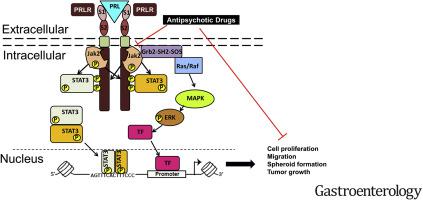当前位置:
X-MOL 学术
›
Gastroenterology
›
论文详情
Our official English website, www.x-mol.net, welcomes your feedback! (Note: you will need to create a separate account there.)
Diphenylbutylpiperidine Antipsychotic Drugs Inhibit Prolactin Receptor Signaling to Reduce Growth of Pancreatic Ductal Adenocarcinoma in Mice.
Gastroenterology ( IF 29.4 ) Pub Date : 2019-11-29 , DOI: 10.1053/j.gastro.2019.11.279 Prasad Dandawate 1 , Gaurav Kaushik 2 , Chandrayee Ghosh 1 , David Standing 1 , Afreen Asif Ali Sayed 1 , Sonali Choudhury 1 , Dharmalingam Subramaniam 1 , Ann Manzardo 3 , Tuhina Banerjee 4 , Santimukul Santra 4 , Prabhu Ramamoorthy 1 , Merlin Butler 3 , Subhash B Padhye 5 , Joaquina Baranda 6 , Anup Kasi 6 , Weijing Sun 6 , Ossama Tawfik 7 , Domenico Coppola 8 , Mokenge Malafa 8 , Shahid Umar 2 , Michael J Soares 9 , Subhrajit Saha 10 , Scott J Weir 11 , Animesh Dhar 1 , Roy A Jensen 12 , Sufi Mary Thomas 13 , Shrikant Anant 14
Gastroenterology ( IF 29.4 ) Pub Date : 2019-11-29 , DOI: 10.1053/j.gastro.2019.11.279 Prasad Dandawate 1 , Gaurav Kaushik 2 , Chandrayee Ghosh 1 , David Standing 1 , Afreen Asif Ali Sayed 1 , Sonali Choudhury 1 , Dharmalingam Subramaniam 1 , Ann Manzardo 3 , Tuhina Banerjee 4 , Santimukul Santra 4 , Prabhu Ramamoorthy 1 , Merlin Butler 3 , Subhash B Padhye 5 , Joaquina Baranda 6 , Anup Kasi 6 , Weijing Sun 6 , Ossama Tawfik 7 , Domenico Coppola 8 , Mokenge Malafa 8 , Shahid Umar 2 , Michael J Soares 9 , Subhrajit Saha 10 , Scott J Weir 11 , Animesh Dhar 1 , Roy A Jensen 12 , Sufi Mary Thomas 13 , Shrikant Anant 14
Affiliation

|
BACKGROUND & AIMS
Prolactin (PRL) signaling is up-regulated in hormone-responsive cancers. The PRL receptor (PRLR) is a class I cytokine receptor that signals via the Janus kinase (JAK)-signal transducer and activator of transcription and mitogen-activated protein kinase pathways to regulate cell proliferation, migration, stem cell features, and apoptosis. Patients with pancreatic ductal adenocarcinoma (PDAC) have high plasma levels of PRL. We investigated whether PRLR signaling contributes to the growth of pancreatic tumors in mice.
METHODS
We used immunohistochemical analyses to compare levels of PRL and PRLR in multitumor tissue microarrays. We used structure-based virtual screening and fragment-based drug discovery to identify compounds likely to bind PRLR and interfere with its signaling. Human pancreatic cell lines (AsPC-1, BxPC-3, Panc-1, and MiaPaCa-2), with or without knockdown of PRLR (clustered regularly interspaced short palindromic repeats or small hairpin RNA), were incubated with PRL or penfluridol and analyzed in proliferation and spheroid formation. C57BL/6 mice were given injections of UNKC-6141 cells, with or without knockdown of PRLR, into pancreas, and tumor development was monitored for 4 weeks, with some mice receiving penfluridol treatment for 21 days. Human pancreatic tumor tissues were implanted into interscapular fat pads of NSG mice, and mice were given injections of penfluridol daily for 28 days. Nude mice were given injections of Panc-1 cells, xenograft tumors were grown for 2 weeks, and mice were then given intraperitoneal penfluridol for 21 days. Tumors were collected from mice and analyzed by histology, immunohistochemistry, and immunoblots.
RESULTS
Levels of PRLR were increased in PDAC compared with nontumor pancreatic tissues. Incubation of pancreatic cell lines with PRL activated signaling via JAK2-signal transducer and activator of transcription 3 and extracellular signal-regulated kinase, as well as formation of pancospheres and cell migration; these activities were not observed in cells with PRLR knockdown. Pancreatic cancer cells with PRLR knockdown formed significantly smaller tumors in mice. We identified several diphenylbutylpiperidine-class antipsychotic drugs as agents that decreased PRL-induced JAK2 signaling; incubation of pancreatic cancer cells with these compounds reduced their proliferation and formation of spheres. Injections of 1 of these compounds, penfluridol, slowed the growth of xenograft tumors in the different mouse models, reducing proliferation and inducing autophagy of the tumor cells.
CONCLUSIONS
Levels of PRLR are increased in PDAC, and exposure to PRL increases proliferation and migration of pancreatic cancer cells. Antipsychotic drugs, such as penfluridol, block JAK2 signaling in pancreatic cancer cells to reduce their proliferation, induce autophagy, and slow the growth of xenograft tumors in mice. These drugs might be tested in patients with PDAC.
中文翻译:

二苯丁基哌啶抗精神病药物抑制催乳素受体信号传导,以减少小鼠胰腺导管腺癌的生长。
背景与目的泌乳素(PRL)信号在激素反应性癌症中被上调。PRL受体(PRLR)是I类细胞因子受体,它通过Janus激酶(JAK)信号转导子和转录激活子以及有丝分裂原激活的蛋白激酶途径发出信号,以调节细胞增殖,迁移,干细胞特征和凋亡。胰腺导管腺癌(PDAC)患者血浆PRL水平较高。我们调查了PRLR信号是否有助于小鼠胰腺肿瘤的生长。方法我们使用免疫组化分析比较了多肿瘤组织微阵列中PRL和PRLR的水平。我们使用基于结构的虚拟筛选和基于片段的药物发现来鉴定可能结合PRLR并干扰其信号转导的化合物。人胰腺细胞系(AsPC-1,BxPC-3,Panc-1和MiaPaCa-2)在有无PRLR基因敲除的情况下(聚簇有规律的间隔的短回文重复序列或小发夹RNA)与PRL或喷氟啶醇一起孵育,并分析其增殖和球状体形成。向C57BL / 6小鼠的胰腺中注射UNKC-6141细胞(有无PRLR抑制),并监测肿瘤发展4周,部分小鼠接受喷氟利多治疗21天。将人胰腺肿瘤组织植入到NSG小鼠的肩cap间脂肪垫中,每天给小鼠注射喷氟利多,持续28天。给裸小鼠注射Panc-1细胞,异种移植瘤生长2周,然后给小鼠腹膜内喷洒氟哌啶醇21天。从小鼠收集肿瘤,并通过组织学,免疫组织化学和免疫印迹进行分析。结果与非肿瘤胰腺组织相比,PDAC中PRLR的水平升高。通过JAK2信号转导子和转录激活子3以及细胞外信号调节的激酶通过PRL激活的信号传导孵育胰腺细胞系,以及形成小球和迁移细胞;在PRLR基因敲低的细胞中未观察到这些活性。PRLR基因敲低的胰腺癌细胞在小鼠中形成明显较小的肿瘤。我们确定了几种二苯丁基哌啶类抗精神病药作为减少PRL诱导的JAK2信号传导的药物。用这些化合物孵育胰腺癌细胞可减少其增殖和形成球体。在不同的小鼠模型中,注射其中一种化合物戊氟哌啶可减缓异种移植瘤的生长,减少肿瘤细胞的增殖并诱导其自噬。结论PDAC中PRLR的水平升高,暴露于PRL会增加胰腺癌细胞的增殖和迁移。抗精神病药(例如喷氟利多)可阻断胰腺癌细胞中的JAK2信号传导,从而降低其增殖,诱导自噬并减缓小鼠异种移植肿瘤的生长。这些药物可能会在患有PDAC的患者中进行测试。
更新日期:2020-04-21
中文翻译:

二苯丁基哌啶抗精神病药物抑制催乳素受体信号传导,以减少小鼠胰腺导管腺癌的生长。
背景与目的泌乳素(PRL)信号在激素反应性癌症中被上调。PRL受体(PRLR)是I类细胞因子受体,它通过Janus激酶(JAK)信号转导子和转录激活子以及有丝分裂原激活的蛋白激酶途径发出信号,以调节细胞增殖,迁移,干细胞特征和凋亡。胰腺导管腺癌(PDAC)患者血浆PRL水平较高。我们调查了PRLR信号是否有助于小鼠胰腺肿瘤的生长。方法我们使用免疫组化分析比较了多肿瘤组织微阵列中PRL和PRLR的水平。我们使用基于结构的虚拟筛选和基于片段的药物发现来鉴定可能结合PRLR并干扰其信号转导的化合物。人胰腺细胞系(AsPC-1,BxPC-3,Panc-1和MiaPaCa-2)在有无PRLR基因敲除的情况下(聚簇有规律的间隔的短回文重复序列或小发夹RNA)与PRL或喷氟啶醇一起孵育,并分析其增殖和球状体形成。向C57BL / 6小鼠的胰腺中注射UNKC-6141细胞(有无PRLR抑制),并监测肿瘤发展4周,部分小鼠接受喷氟利多治疗21天。将人胰腺肿瘤组织植入到NSG小鼠的肩cap间脂肪垫中,每天给小鼠注射喷氟利多,持续28天。给裸小鼠注射Panc-1细胞,异种移植瘤生长2周,然后给小鼠腹膜内喷洒氟哌啶醇21天。从小鼠收集肿瘤,并通过组织学,免疫组织化学和免疫印迹进行分析。结果与非肿瘤胰腺组织相比,PDAC中PRLR的水平升高。通过JAK2信号转导子和转录激活子3以及细胞外信号调节的激酶通过PRL激活的信号传导孵育胰腺细胞系,以及形成小球和迁移细胞;在PRLR基因敲低的细胞中未观察到这些活性。PRLR基因敲低的胰腺癌细胞在小鼠中形成明显较小的肿瘤。我们确定了几种二苯丁基哌啶类抗精神病药作为减少PRL诱导的JAK2信号传导的药物。用这些化合物孵育胰腺癌细胞可减少其增殖和形成球体。在不同的小鼠模型中,注射其中一种化合物戊氟哌啶可减缓异种移植瘤的生长,减少肿瘤细胞的增殖并诱导其自噬。结论PDAC中PRLR的水平升高,暴露于PRL会增加胰腺癌细胞的增殖和迁移。抗精神病药(例如喷氟利多)可阻断胰腺癌细胞中的JAK2信号传导,从而降低其增殖,诱导自噬并减缓小鼠异种移植肿瘤的生长。这些药物可能会在患有PDAC的患者中进行测试。


























 京公网安备 11010802027423号
京公网安备 11010802027423号